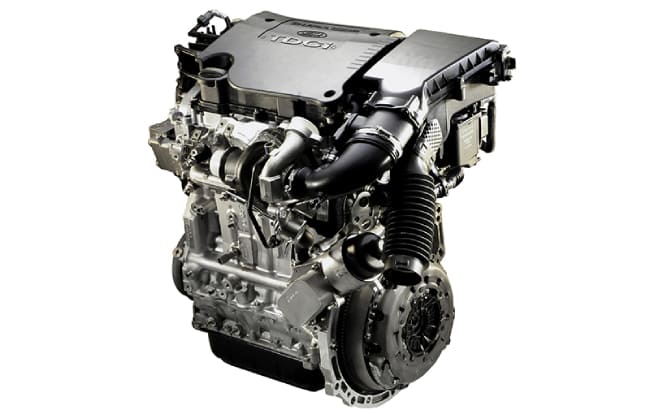
TDCi are diesel engines with turbocharger and common rail injection system, installed in Ford models. They were introduced in 2000. Some engines are built by Ford Motor Company itself, while others are manufactured by Groupe PSA (now Stellantis).
Features of TDCi Engines
Each TDCi engine has 4 cylinders with 8 or 16 valves. Depending on the version, the engine block is made of aluminum or cast iron. In addition, the cylinder head can also be made of aluminum or cast iron. The engine can be turbocharged, often with variable geometry. The valve control unit is usually driven by a belt. But there are also versions with a chain or a combination of strap and chain.

Popular TDCi -Engines
| Version name | Index | Displacement, l | Number of valves | Max. Power, hp | Max. Torque, Nm | Year of manufacture | Ford models equipped with this type of engine |
| Duratorq DLD-414 | F6JA | 1.4 | 8 | 68 | 160 | 2002 | Fusion; Fiesta Mk5. |
| Duratorq DLD-415 | UGJC | 1.5 | 8 | 75 | 185 | 2012 | B-Max; Fiesta Mk5. |
| DLD-416 | GPDA, GPDC | 1.6 | 16 | 90 | 215 | 2005 | Focus Mk1; C-Max. |
| DLD-416 | G8DA; G8DB | 1.6 | 16 | 109 | 240 | 2003 | Focus C Max; Focus Mk2. |
| Duratorq DLD-418 | HCPA | 1.8 | 8 | 90 | 227 | 2002 | Focus C-Max; Transit Connect Mk1. |
| DLD-418 | FFDA | 1,8 | 8 | 100 | 240 | 2002 | Focus Mk1. |
| DLD-418 | KKDA; KKDB | 1,8 | 8 | 115 | 280 | 2004 | C-Max; Focus Mk1. |
| DLD-418 | QYWA | 1,8 | 8 | 125 | 320 | 2006 | Galaxy Mk2; S-MAX Mk1. |
| Duratorq DW | QXWA | 2.0 | 16 | 140 | 320 | 2006 | S-MAX Mk1; Galaxy Mk2. |
| Duratorq DW | TXDA | 2.0 | 16 | 340 | 2010 | Kuga Mk1. | |
| Duratorq DW | 2,2 | 16 | 175 | 400 | 2008 | Mondeo Mk4. | |
| Duratorq DW | KNWA | 2,2 | 16 | 200 | 420 | 2010 | Galaxy Mk2; C-Max. |
| TDCi Duratorq | FMBA | 2.0 | 16 | 130 | 330 | 2002 | Mondeo Mk3. |
| TDCi Duratorq | QJBB | 2,2 | 16 | 155 | 360 | 2004 | Mondeo Mk3. |
| TDCi Duratorq | JXFA | 2,4 | 16 | 115 | 310 | 2006 | Transit Mk6. |
Common defects of TDCi engines
| Defects | Engines |
| The injectors break prematurely. | F6JA; FFDA; JXFA; KKDA; KKDB; FMBA; TXDA; KNWA; Q4BA; QJBB; TXDA; HCPA. |
| There is a high risk of thermal damage to the engine pistons due to excessive fuel delivery to the injectors. | FFDA; KKDA; KKDB; HCPA. |
| Wear of the cylinder piston assembly increases engine oil consumption. | F6JA. |
| The turbocharger has a short lifetime. | GPDA; GPDC; F6JA. |
| The front motor mount has a short lifespan. | F6JA. |
| Carbon deposits build up quickly in the EGR valve. | TXDA; KNWA; Q4BA; UGJC. |
| After a relatively low mileage, the diesel particulate filter becomes clogged. | UGJC; Q4BA; KNWA; TXDA. |
| Fuel system components wear out quickly. | G8DA; UGJC; G8DB. |
| The camshafts wear out prematurely and their timing chain wears out. | GPDA; GPDC; G8DA; QXWA; G8DB. |
| Injector washers burn out regularly. | GPDA; G8DA; G8DB; GPDC. |
| Carbon deposits form quickly on the engine. | GPDA; G8DA; G8DB; GPDC. |
| Over time, the hydraulic supports will leak. | GPDA; GPDC; G8DB; G8DA. |
| The crankshaft damper disc and also the crankshaft position sensor fail prematurely. | HCPA; KKDA; QYWA; FFDA. |
| Fuel system elements are susceptible to air locks. | QYWA. |
| In the Hydraulic valve lifters may malfunction early, causing a knocking noise. | QXWA; TXDA. |
| Vibration will cause electrical wiring failure and electronic control unit malfunction. | QXWA; TXDA. |
| Contaminants in the fuel damage the fuel pump shaft. | JXFA; FMBA. |
| The small eye of the connecting rod shaft is destroyed. | FMBA; JXFA; QJBB. |
